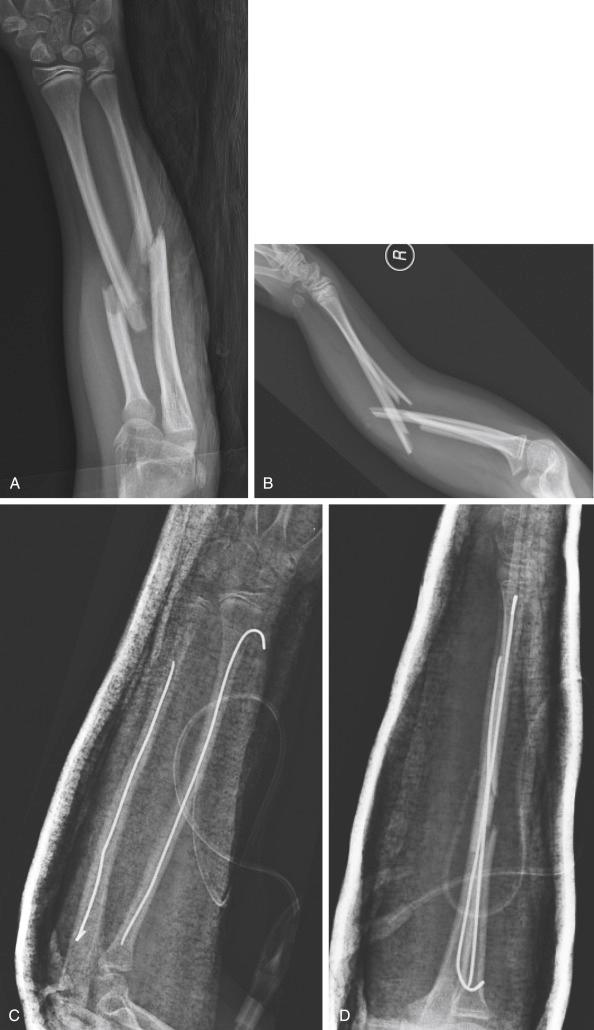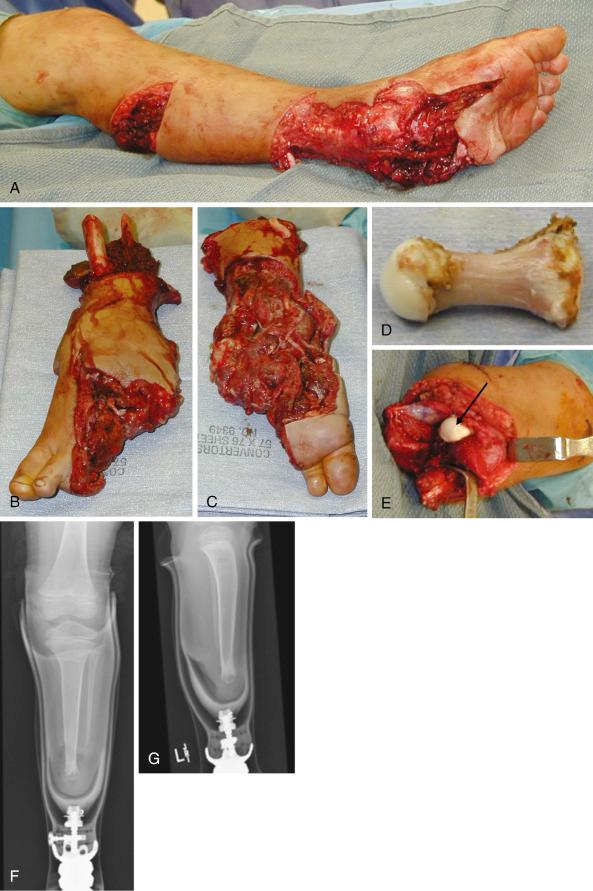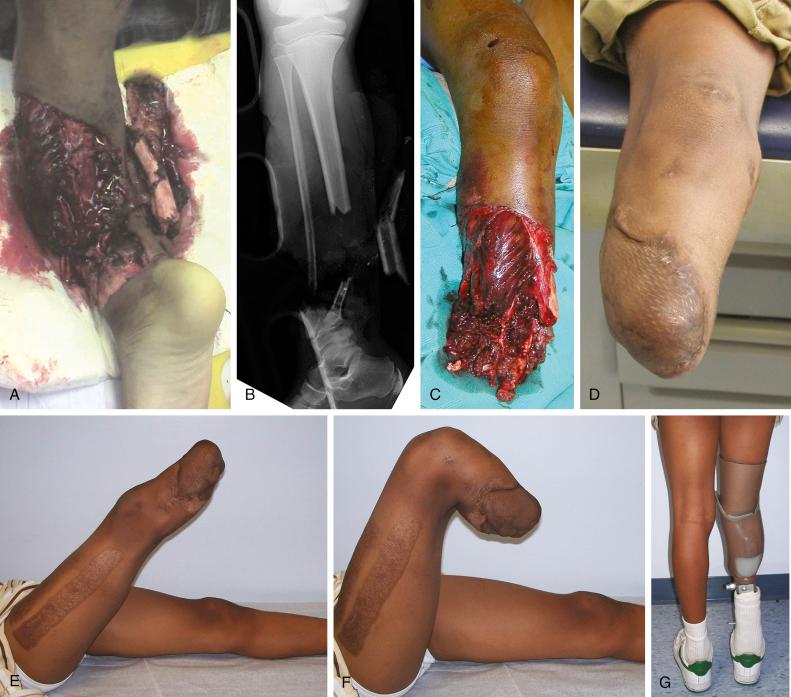Physical Address
304 North Cardinal St.
Dorchester Center, MA 02124
The author would like to acknowledge Fred F. Behrens, MD (deceased), for his contributions to earlier versions of this chapter.
It is generally accepted that open fractures among children have better clinical outcomes than similar injuries in adults, but high-level comparative studies are lacking. Although skeletal maturity and preexisting conditions (such as osteogenesis imperfecta) influence the injury patterns of open fractures, it is primarily the kinetic energy E k = mv 2 /2 that determines the severity of bone and soft tissue damage of a particular injury. Thus, closed pediatric fractures are largely caused by low-energy domestic activities and play, whereas over 80% of open fractures in children over 2 years are caused by violent accidents. Even in adolescents, athletic activities account for less than 5% of open fractures. Although some open fractures occur through the physes, the majority are located in the diaphyses. Open fractures in children younger than school age are rare because of their small body mass, the large amount of protective subcutaneous fat, and their limited exposure to high-risk activities.
Most classifications of open musculoskeletal injuries account for the size, severity, and extent of the soft tissue lesion but neglect such modifying factors as wound contamination, fracture pattern, and associated injuries. The open fracture classification that is still most popular for both children and adults was developed by Gustilo and Anderson in 1976 and divides open fractures into three types according to the severity of the soft tissue injury. It was further refined in 1984 to allow for better differentiation of the most severe injuries ( Table 6.1 ). The Gustilo classification continues to be widely used and does help guide treatment and predict clinical outcomes such as risk of wound infections. However, the interobserver reliability and reproducibility of this classification system has been an area of some debate.
| Type | Description |
|---|---|
| I | Skin opening of ≤1 cm, quite clean; most likely from inside to outside; minimal muscle contusion; simple transverse or short oblique fractures |
| II | Laceration >1 cm long, without extensive soft tissue damage, flaps, or avulsion; minimal to moderate crushing component; simple transverse or short oblique fractures with minimal comminution |
| III | Extensive soft tissue damage, including muscles, skin, and neurovascular structures; often a high-velocity injury with a severe crushing component |
| IIIA | Usually results from high-energy trauma; however, soft tissue coverage of the fractured bone still adequate, despite extensive soft tissue laceration or flaps |
| IIIB | More extensive soft tissue injury (than type IIIA) with periosteal stripping and bone exposure; usually associated with massive contamination |
| IIIC | Any open fracture associated with arterial injury requiring repair, independent of the fracture type |
In type I open fractures, the wound is less than 1 cm long. It is often a clean puncture wound in which a spike of bone has pierced the skin. These fractures are accompanied by minimal soft tissue damage and no sign of crushing injury. The fracture pattern is typically transverse, or short oblique, with little comminution, if any ( Fig. 6.1 ), and this most commonly occurs with a both bone forearm fracture in the skeletally immature patients.

In type II open fractures, the laceration is greater than 1 cm in length, but no extensive soft tissue damage is present. These fractures are associated with a slight or moderate crushing injury, moderate comminution at the fracture site, and moderate contamination.
Type III injuries are characterized by extensive damage to skin, muscle, bone, and, possibly, neurovascular structures. A high degree of contamination may be present. Type III injuries are divided into three subgroups. In type IIIA, soft tissue coverage of the fractured bone is adequate, despite the extensive injury. This subtype includes segmental and severely comminuted fractures from high-energy trauma, regardless of the size of the wound. A type IIIB injury has extensive soft tissue disruption or loss, with periosteal stripping and exposure of bone. Massive contamination and comminution of the fractures are common. A local rotational or free flap is needed to obtain satisfactory wound coverage. Type IIIC includes any open fractures associated with an arterial injury that needs repair, regardless of the extent of soft tissue damage. The incidence of wound infection, delayed union, nonunion, amputation, and residual disability is directly related to the type of soft tissue injury. The more severe the injury, the greater the risk of complications. Based on a systematic review of the literature related to open tibial fractures in children and adolescents, age older than 10 years and type III open fractures were associated with complications and outcomes similar to those reported in adults.
Open fractures inflicted by lawn mowers ( Fig. 6.2 ) and farm machinery deserve particular attention because both generate highly contaminated open injuries, mainly through the impact of debris or through the direct force of the cutting blades, which can rotate at 3000 rpm and generate about 2100 foot-pounds of kinetic injury. This amount of kinetic energy creates trauma analogous to a blast injury, leads to amputation in up to 82% of cases, and is often associated with compartment syndrome. Such injuries most commonly afflict children younger than 14 years (median age 6 years old), with younger children having a higher Injury Severity Score. Farm and lawn mower injuries are often complicated by posttraumatic infections with mixed flora, mostly gram-negative bacilli.

Another unique class of injuries includes those sustained from earthquakes, because the vast majority (87%) of survivable injuries from earthquakes are orthopedic in nature. More than half of these fractures are of the lower extremity, most commonly diaphyseal tibia (27%) and femur (17%). These injuries often have associated severe soft tissue crush or open injuries from falling debris along with extensive fracture comminution. Damage control orthopedics is the treatment of choice, especially when resources are limited, and initial management should focus on hemorrhage control, wound débridement, infection control, and soft tissue stabilization. Where contamination is severe, multiple débridements should be performed before definitive fixation.
Unfortunately, blast and land mine injuries related to acts of terrorism can also affect children and have grave consequences, including a 7% mortality rate. Modern low-intensity warfare in conflict regions has resulted in more children experiencing battlefield injuries. Compared with adolescents and adults, young children exposed to terror explosions tend to have greater injury severity, including traumatic brain injury, but may have a lower prevalence of open wounds and lower extremity injuries. That said, in the setting of severe traumatic wounds, hemorrhage control, either with tourniquet or hemostatic dressing, is the most common and effective prehospital (PH) intervention. Sokol et al emphasized the importance of training of PH personnel in application of hemorrhage control techniques in pediatric casualties.
With advances in PH resuscitation and the development of free flaps and microvascular reconstruction, many limbs with extensive open fractures that involve vascular compromise or partial amputation can now be salvaged. However, despite the great potential for healing that is typical in children, some of the more severe open fractures are better managed with primary amputation ( Figs. 6.2 and 6.3 ) rather than with extensive reconstructive procedures that leave the patient with a dubious cosmetic result and only marginal function. To provide some guidance when deciding between limb salvage and amputation, a number of investigators have developed severity indices, although their applicability and translation to pediatric injuries is controversial. In 1990, Johansen and associates developed the Mangled Extremity Severity Score (MESS), a rating scale for lower extremity trauma based on skeletal and soft tissue damage, limb ischemia, shock, and age of the patient ( Table 6.2 ). The evidence for using MESS in children suffers from low numbers of patients because of the rarity of these injuries. In a series of type III open lower extremity fractures, the MESS accurately predicted successful limb salvage in 93% and amputation in 63% of children. In a review of pediatric open fractures of the lower extremity, a MESS of 6.5 or greater was a reasonable predictor of the need for amputation. In a rebuttal to that article, Stewart et al describe few failures of limb salvage in children and caution against using MESS, particularly for a score of 6.5, which is lower than the adult standard, or any severity score, as an indication for primary amputation in the pediatric population, as children tend to have better clinical outcome with nerve repair, more likelihood of fracture union, lower wound infection rates, and better use of injured limbs because of neural plasticity. They present their experience showing lack of specificity and low positive predictive value of multiple scoring systems in children, which suggest that strict adherence to scoring systems may lead to unnecessary amputations. The Ganga Hospital Open Injury Severity Score (GHOISS, which includes scoring for skin and fascia, bone and joint, musculotendinous and nerve units, and comorbid conditions) was published recently and has been applied to type IIIB open fractures in children with open physes. A GHOISS of greater than or equal to 17 was found to be a better predictor of amputation as compared with a MESS of greater than 7.

| Variable | Points |
|---|---|
| Skeletal/Soft Tissue Injury | |
| Low energy (stab, simple fracture, “civilian” gunshot wound) | 1 |
| Medium energy (open or multiple fractures, dislocation) | 2 |
| High energy (close-range shotgun or “military” gunshot wound, crush injury) | 3 |
| Very high energy (same as high energy plus gross contamination, soft tissue avulsion) | 4 |
| Limb Ischemia | |
| Pulse reduced or absent but perfusion normal | 1 a |
| Pulseless; paresthesias, diminished capillary refill | 2 a |
| Cool, paralyzed, insensate, numb | 3 a |
| Shock | |
| Systolic blood pressure always >90 mm Hg | 0 |
| Hypotensive transiently | 1 |
| Persistent hypotension | 2 |
| Age (Years) | |
| <30 | 0 |
| 30–50 | 1 |
| >50 | 2 |
Regardless of decision-making modalities, there is no substitute for evaluation by experienced surgeons with widespread consultation from multiple individuals including orthopedic surgeons, plastic surgeons, anesthesiologists, and critical care specialists. It is also imperative to ensure that parents are counseled that salvage in the setting of severe injury and high injury severity scores may be a long process with uncertain outcome, and some of these children may ultimately need a secondary amputation.
It has become increasingly clear that some closed fractures caused by violent force may result in extensive destruction of the soft tissue sleeve surrounding the leg and pelvis without resulting in an open lesion. These closed fractures with severe soft tissue injury are characterized by skin contusions, deep abrasions, burns, or frank separation of the cutis from the subcuticular tissue. Even in children, these lesions can result in partial or full tissue loss and secondary infection of the fracture site. To avoid catastrophes, surgeons must treat these lesions as open fractures, which facilitates repeated injury evaluation and decreases complications. Tscherne and Gotzen provided a classification that describes four grades of these treacherous injuries that may prove useful in choosing among different treatment options ( Table 6.3 ).
| 0 | Minimal soft tissue damage; indirect violence; simple fracture patterns (e.g., torsion fracture of the tibia in skiers) |
| I | Superficial abrasion or contusion caused by pressure from within; mild to moderately severe fracture configuration (e.g., pronation fracture-dislocation of the ankle joint with a soft tissue lesion over the medial malleolus) |
| II | Deep contaminated abrasion associated with localized skin or muscle contusion; impending compartment syndrome; severe fracture configuration (e.g., segmental “bumper” fracture of the tibia) |
| III | Extensive skin contusion or crush; underlying muscle damage may be severe; subcutaneous avulsion; decompensated compartment syndrome; associated major vascular injury; severe or comminuted fracture configuration |
A unique class of these injuries includes concealed degloving injuries, the Morel-Lavallée lesion, which is rare in children but can be seen in fractures (usually peri-pelvic) caused by motor vehicle, train, and ATV accidents as well as lower-energy sports mechanisms. Hallmark physical findings include a soft fluctuant area caused by collection of blood and lymphatic fluid, and the diagnosis is best confirmed with magnetic resonance imaging. Management of these lesions can include compressive bandages and bedrest in mild lesions, or percutaneous drainage with or without sclerotherapy. In acute lesions with underlying fractures, surgical débridement is usually necessary.
Although most bony and soft tissue disruptions in children have a greater healing potential, the treatment goals and principles of open musculoskeletal injuries in children are the same as those for adults. The principal goals in managing open fractures are restoration and preservation of vital functions, prevention of wound infection, healing of the soft tissue injuries, restoration of bony anatomy and bone union, and recovery of optimal physical and psychosocial function.
These objectives are best attained by prompt initial resuscitation, thorough and complete evaluation of life-threatening injuries followed by a detailed assessment of the fracture site, appropriate antimicrobial therapy at presentation, extensive and possibly repeated wound débridement followed by wound coverage, fracture stabilization, autogenous bone grafting when needed, restoration of major bony defects, and comprehensive functional and psychosocial rehabilitation. These interventions often overlap or occur in a modified temporal sequence, depending on age, injury pattern, and associated lesions. They are also highly interdependent; the type and timing of wound closure, for instance, may affect the choice of fracture fixation.
Acute care follows the general guidelines that have been established for similar injuries in adults. In addition to appropriate and timely acute intervention, the final clinical outcome of these injuries depends on a comprehensive plan of rehabilitation that includes physical therapy as well as educational and socioeconomic support for the family.
PH care of a trauma patient with severe fracture and soft tissue injury follows the ABCD algorithm with attention to cervical spine immobilization. After assessment and initial management of airway and breathing, bleeding, disability, and deformity should be addressed. At the scene of the injury, the open wound is covered with a sterile dressing, if available. Profuse bleeding such as with vascular injury or amputation is controlled by local compression or preferably a tourniquet. PH intervention with a tourniquet is an active area of military training that even prioritizes hemorrhage control over airway issues. Tourniquets have been shown to be safe and effective in severely injured pediatric patients. With bleeding under control, a fracture may be managed by gentle traction, manipulation, and splinting in a comfortable position for transport to the emergency department.
In the emergency department, an Advance Trauma Life Support protocol is followed. One or more intravenous lines are established. Tetanus prophylaxis and the first intravenous dose of appropriate antibiotic(s) are administered upon arrival to the emergency department for an open fracture. After the history is taken and the physical examination is completed, including inspection of wounds (although dressings should be taken down as few times as needed for appropriate decision-making in the emergency department), pertinent radiographs are obtained, and blood is drawn for a complete blood count, typing, and cross-matching and for determination of serum electrolyte levels. Severely displaced fractures, especially when compromising the integrity of the overlying skin or associated with neurovascular deficits, should be realigned and splinted in the emergency department. Any patient with a suspected dysvascular limb is transferred to the operating room without delay for further assessment and possible vascular exploration and repair. Preoperative angiography is not routinely recommended because it further prolongs the warm ischemia time. At some pediatric trauma centers, instituting a lower extremity vascular trauma protocol has been shown to improve the timeliness of vascular care to ensure that ischemia time does not exceed the critical period of 6 to 8 hours.
It is prudent to assume that all open fractures and closed lesions covered with devitalized tissue are contaminated. Frank infections are more likely to develop if necrotic tissue remains in the wound. The infection rates in open pediatric fractures are somewhat lower than adults. Patzakis and Wilkins reported only one infection (1.8%) in 55 open fractures in children. In contrast, they had an overall infection rate of 7.2% in 1049 open adult fractures. In a series of 554 open pediatric fractures, Skaggs and colleagues reported a 3% overall infection rate, and the incidence was 2% in type I and II injuries and 8% in type III fractures. Typically, the infecting organisms are Staphylococcus aureus and aerobic or facultative gram-negative rods in fractures with less severe soft tissue injury, whereas mixed flora prevails in type IIIB and IIIC lesions. Among all open fractures, Patzakis and Wilkins found the highest infection rate in tibial lesions, presumably caused by the limited soft tissue envelope and relatively poor vascularity. In two studies of open tibial fractures in children, the overall infection rates were 10% and 11%, similar to those reported in adults. No infections developed in type I fractures, whereas infection rates were approximately 12% in type II injuries and 21% to 33% in type III fractures.
Become a Clinical Tree membership for Full access and enjoy Unlimited articles
If you are a member. Log in here